- Jewelry
- Inspiration
- Good Deals
- Paintings
- About
- Contact
JEWELRY
- Anklet
- Bracelets
- Brooches
- Cufflinks
- Earrings
- Pendants & Necklaces
- Rings
- Draw your jewelry
- GOOD DEALS
- How to clean your jewel
- Metal we used
INSPIRATION
When giving flowers becomes eternal: a collection of commemorative jewelry to celebrate and remember
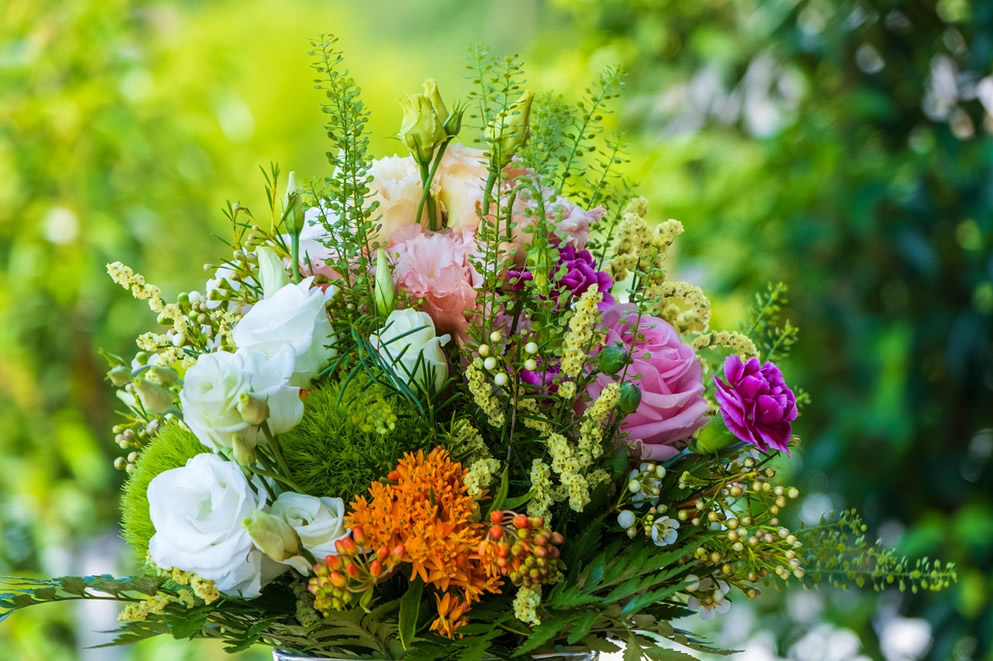
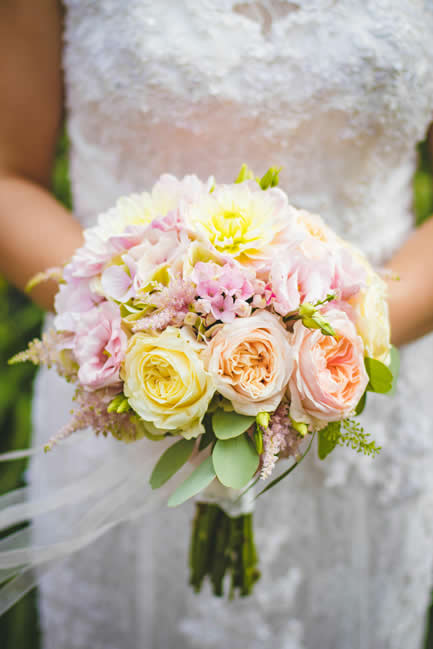
At EmmanuelleGuyon, we hold a deep affection for nature, plants, and botany — and, above all, for the ancient and essential bond that links humans to the vegetal world. From their most fundamental uses — to nourish, to heal, to adorn — to the symbols they inspire, this connection has endured through centuries and across civilizations.
We’ve devoted an entire page to the language of flowers — to what plants say on our behalf, and to all that we project onto them. As we explored this rich world, we discovered countless occasions to celebrate, honor, or commemorate through flowers. This is where the idea for this collection of jewelry was born: pieces designed to accompany those precious, unique, and often deeply emotional moments.
A bouquet of flowers is a powerful gesture. It conveys feelings, tells a story, and creates a memory. Yet its beauty is fleeting. Even when we try to preserve it — by drying the flowers, framing them, or caring for them with devotion — time eventually takes its toll. What remains is the memory.
This is precisely what guided us in creating this collection: to prolong that symbolic gesture through jewelry — a lasting echo of the moment shared. Offered alongside the flowers, it doesn’t replace nature — we could never rival its fragrance, textures, or colors — but it can preserve its trace.
A floral jewel then becomes a small talisman, a delicate reminder, filled with memory and emotion. An object kept close, long after the petals have fallen — an intimate continuation of what was shared.
These events, and the symbols attached to each flower, vary from one country to another, depending on whether the plant is native to the region, its seasonality, or the cultural bond people share with it. That’s why we’ve chosen to focus on the most widespread and universal symbols.
The following list is a summary of some flowers you can find in our jewelry. If a flower you cherish is missing, don’t hesitate to contact us — we would be delighted to create it for you. And while most of our current designs are rings, we’re happy to explore other forms — pendants, earrings, bracelets... whatever you dream of. Let's talk about it together.
Birth flowers by month
Just like birthstones, there are now birth flowers — each month of the year associated with one or more flowers. Though this list is sometimes presented as an ancient tradition, it has recently gained popularity again, thanks in part to the work of florists.
In truth, we have found no clearly defined ancient tradition corresponding to this modern version. However, several historical elements likely contributed to its emergence. For instance, the Romans associated specific flowers with certain months to honor the gods, and since the Middle Ages, various flowers have been linked to saints in the liturgical calendar.
Whether it stems from commerce or tradition, the gesture remains rich in beauty and symbolism. It fits seamlessly into the long-standing tradition of the language of flowers, which dates back many centuries.
January: Carnation, Snowdrop, and Hellebore
The year begins under a blanket of snow, yet already the first signs of spring stir. In the heart of winter, these flowers demonstrate quiet strength, blooming where none are expected. They remind us that even in the darkest days, life always finds a way. Each carries a message of hope, perseverance, and inner beauty.

- Carnation: A symbol of sincere and profound love, the carnation evokes fidelity, quiet passion, and lasting tenderness. With its delicate petals and remarkable resilience, it embodies the gentle strength of feelings that endure over time. When given at the start of the year, it represents the promise of a solid bond, able to withstand the seasons. Its wide range of colors also allows for a subtle expression of varied emotions.
- Snowdrop: A true emblem of renewal, the snowdrop pushes through the snow to herald a rebirth that is not yet visible. It speaks of delicacy that persists despite adversity, the light at the end of the tunnel, and hope that endures even in the heart of winter. Its early blooming makes it a symbol of quiet courage and resilience. It is a flower that soothes and reassures.
- Hellebore (Christmas rose): Majestic and serene, the hellebore is a winter flower that symbolizes peace of mind and perseverance. Its elegant appearance, sometimes tinged with deep purple or pure white, expresses inner beauty and discretion. Known since Antiquity for its medicinal uses, it is also associated with emotional healing. In the language of flowers, it evokes patience, protection, and inner peace.
February: Violet, Iris, and Primrose
The heart of winter calls for gentleness of feeling and inner sincerity. At a time when nature still seems asleep, these delicate flowers reveal the depth of silent emotions. They whisper hope, loyalty, and quiet promises, like a softly spoken secret. February — a month of intimacy and heartfelt gestures — is adorned with symbols both tender and profound.
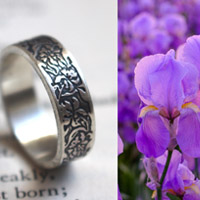
- Violet: Discreet and fragrant, the violet evokes modesty, fidelity, and deep bonds that endure through time. Its humble appearance contrasts with the richness of its symbolism: innocence, humility, secret love, and lasting memory. In many traditions, it is also associated with spiritual wisdom and a gentle form of mysticism. It is the flower of quiet love and deep thoughts.
- Iris: An elegant flower with fan-shaped petals, the iris is a messenger of trust and hope. Its name, drawn from the Greek goddess of the rainbow, makes it a bridge between heaven and earth, between emotion and wisdom. It symbolizes sincere love, unwavering faith, loyalty, and clarity of intention. Offering an iris in February is a way of revealing noble feelings and a respectful form of affection.
- Primrose: As the first herald of spring, the primrose speaks of youth, nature’s awakening, and the beginning of tender love. It is a joyful, luminous flower that symbolizes fresh and spontaneous emotions. It tells of the thrill of a first glance, budding promises, and the candor of timid feelings. In the language of flowers, it also expresses sincere attachment and the sweetness of childhood memories.
March: Daffodil and Magnolia
Spring is near, the days grow longer, and nature is reborn in an explosion of light and promise. March marks the return of life after winter’s stillness, and with it come the first brilliant blooms. The earth slowly awakens, and these flowers symbolize the gentle transition from winter introspection to the vital surge of renewal. They celebrate the return of light, hope, and beauty in motion.

- Daffodil: Bright and vibrant, the daffodil is the ultimate messenger of spring. It embodies the awakening of nature, spontaneous joy, and the excitement of the season’s first gentle days. In the language of flowers, it also conveys the patient longing for a love that has yet to blossom, but whose promise remains intact. It symbolizes renewed hope, radiance after darkness, and the reward of a persevering heart.
- Magnolia: Both grand and delicate, the magnolia embodies quiet strength and majestic beauty. Its large, pristine flowers evoke feminine grace, dignity, and the nobility of the soul. In some Asian cultures, it is associated with purity of heart and steadfastness through adversity. A flower of resilience and elegance, the magnolia reminds us that strength can be expressed through softness and refinement.
April: Sweet Pea, Tulip, and Daisy
Gardens come alive with soft pastel hues, full of freshness and promise. April brings a breath of lightness and rustic elegance, like a whisper of spring fully asserting itself. These flowers, tender yet expressive, convey delicate and sincere emotions, heartfelt impulses, and precious bonds. They celebrate subtle feelings and gentle moments, suspended between blooming and hope.
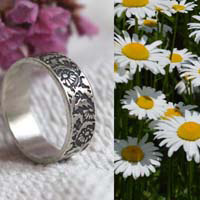
- Sweet Pea: With its soft petals and delicate fragrance, the sweet pea evokes the gentleness of emotions and unspoken gratitude. It is a flower associated with appreciation, kind thoughts, and sincere wishes. It also symbolizes gentle farewells—the kind that leave a joyful memory despite the parting. It expresses loyal friendship, deep bonds, and tender feelings carried on the breeze.
- Daisy: The quintessential meadow flower, the daisy embodies joyful simplicity and purity of heart. A symbol of innocence, soul freshness, and sincerity, it speaks of unpretentious happiness. It recalls childhood games, spontaneous love, and the quiet promise of renewal. In the language of flowers, it is often offered as a message of sweet, hopeful, and naive affection.
- Tulip: Graceful and generous, the tulip charms with its rounded shape and bold colors. It symbolizes pure love—tender or passionate depending on its shade—and a sincere declaration without pretense. In some traditions, it rivals the rose in expressing deep emotions, though in a gentler way. It is also given as a symbol of simple beauty, enduring affection, and the blooming of desire.
May: Lily of the Valley, Hawthorn, and Lilac
The bells of lily of the valley ring like a wish for happiness, and white hedgerows burst into brilliant bloom. May is the month of renewed joy, floral abundance, and the promise of a near summer. It is a luminous time, rich with ancient symbols and springtime celebrations. These flowers tell stories of innocence, vitality, and the emotions that mark new beginnings.
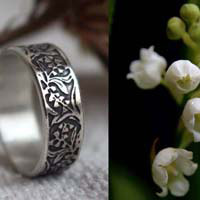
- Lily of the Valley: Fragile and delicate, the lily of the valley carries a powerful symbolism deeply rooted in European traditions. It represents offered luck, spontaneous joy, purity of feeling, and the humility of a tender gesture. Its white bells are like pearls of happiness, given as tokens of sincere friendship or discreet love. As the emblematic flower of May 1st, it brings gentle wishes and light emotions.
- Hawthorn: A flower of country hedgerows, hawthorn is a sacred plant in many ancient cultures, often linked to rites of renewal. It symbolizes fertility, prosperity, but also protection and resilience in the face of life’s storms. With its small white blossoms and subtle thorns, it embodies quiet strength, perseverance, and the balance between softness and defense. It is a guardian of natural cycles, poised between fragility and robustness.
- Lilac: Fragrant and generous, lilac evokes first stirrings of love, heart flutters, and the promise of a still-shy romance. It symbolizes youth, the awakening of the senses, and blossoming emotions. In many regions, its blooming marks a significant moment in May, filled with nostalgia and romance. Whether pale purple, white, or deep violet, lilac carries tender memories and fresh feelings.
June: Rose, Honeysuckle, and Peony
Summer draws near, carried by love and heady scents. June is a sensual and radiant month, where emotions are freely expressed, blooming alongside lush, intoxicating flowers. Gardens flourish with bold blossoms that celebrate connection, beauty, and meaningful bonds. These flowers accompany grand declarations as well as the quietest whispers of the heart.
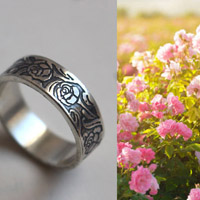
- Rose: The undisputed queen of flowers, the rose comes in an infinite range of shades, each carrying a unique message. Red celebrates passionate love and burning desire; pink speaks of gentleness and tenderness; white expresses purity and respect; yellow evokes joyful friendship—or, at times, jealousy. To offer a rose is to reveal one’s feelings with grace, whether they are secret, budding, or fully blossomed.
- Honeysuckle: A climbing plant with a heady fragrance, honeysuckle wraps itself around its support with quiet strength. It symbolizes faithful love, deep attachment, and enduring tenderness. It is often associated with bonds that stand the test of time, loyalty in relationships, and spiritual union. Its sweet scent, which intensifies at dusk, conjures lasting memories and stubborn promises.
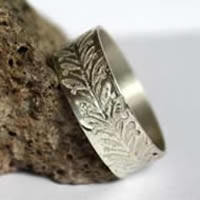
- Peony: Lush and delicate, the peony embodies radiant femininity, romantic love, and the joys of a fulfilled heart. It is often associated with marital happiness, prosperity, and graceful beauty. Highly valued in China and Japan, where it symbolizes wealth and nobility, it is also beloved in European gardens for its generous blooms. A flower of confidences and celebrations, the peony also evokes the refined yet simple pleasures of summer.
July: Delphinium, Lotus, Water Lily, and Sunflower
The height of summer unfolds in a light that is both dazzling and soothing. July is a hymn to abundance, solar warmth, and inner blossoming. The flowers of this month speak of clarity, gentle strength, and emotional generosity. They inspire confidence, peace, and radiant vitality.
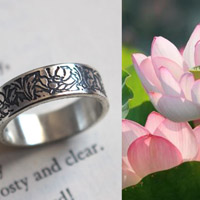
- Delphinium (Larkspur): With its tall spires reaching skyward and its shades of blue, violet, or white, the delphinium symbolizes lightness, kindness, and spiritual elevation. It also evokes shared joy, open-heartedness, and affectionate protection. A flower of country gardens and summer bouquets, it embodies nobility of spirit, sincere friendship, and expressive sensitivity.
- Water Lily: The quintessential aquatic flower, the water lily unfolds serenely on the surface of still waters. It represents inner peace, purity of heart, and the search for serenity amid life’s turbulence. Its seemingly calm presence hides a deep life force rooted in the mud, making it a symbol of introspection and spiritual growth. It inspires calm, daydreaming, and a deep connection with nature.

- Lotus: Rising from dark waters to offer an unblemished and radiant bloom, the lotus is a powerful symbol of resilience, wisdom, and transcendence. In Asian traditions, it is associated with purity of the soul, spiritual growth, and inner awakening. It reminds us that beauty and peace can emerge from the depths, and that it is possible to rise above adversity. The lotus embodies personal fulfillment and universal harmony.
- Sunflower: Tall and generous, the sunflower turns toward the light, a living metaphor for loyalty, genuine joy, and optimism. It represents radiant enthusiasm, devotion to loved ones, and steadfastness in the face of challenges. Its presence in summer fields evokes abundance, warmth, and the brightness of life. A truly solar flower, it inspires energy, vitality, and confidence.
August: Gladiolus, Poppy, and Dahlia
This is the month of harvest, courage, and tender memories. August blends the radiant warmth of summer days with a subtle nostalgia for all that has been achieved. The flowers of this season evoke quiet strength, gratitude, elegance, and the deep emotions we hold close to our hearts.

- Gladiolus: Upright and majestic, the gladiolus symbolizes inner strength, resilience, and the nobility of the heart. With its tall, sword-like stance, it is often associated with victory, triumph over adversity, and personal pride. It also represents sincere admiration, courage in the face of trials, and a form of understated yet resolute beauty. Offering a gladiolus is a tribute to someone’s bravery and perseverance.
- Poppy: Light as a breath, yet vivid in its crimson hue, the poppy is a flower full of paradoxes. It evokes fleeting passion, delicate intensity, and the fragility of deep emotions. A symbol of remembrance and consolation, it is often linked to cherished memories, absent loved ones, and moments of regained peace. In summer fields, it serves as a gentle reminder to live each moment fully, no matter how brief.

- Dahlia: Refined and abundant, the dahlia flower embodies quiet strength and emotional commitment. It speaks of dignity in adversity, elegance of character, and calm confidence. Yet behind its many layered petals may also lie more ambivalent feelings, such as inconstancy or the tensions of unfulfilled love. The dahlia, in all its complexity, reflects the depth, contrasts, and subtleties of human relationships.
September: Aster, Morning Glory (Ipomoea), and Anemone
Time begins to slow, autumn draws near, and flowers take on a more delicate appearance, as if suspended between two seasons. Colors soften, daylight gently fades, and each bloom seems to hold a touch of nostalgia and quiet hope.
- Aster: A floral star of late summer, the aster brightens gardens just as many other blooms begin to fade. It symbolizes enduring love, loyalty, and patience in waiting. A flower of sincere and lasting bonds, it also speaks to the wisdom gained through time and the beauty of deep attachment. Its late blooming reminds us that even long-awaited promises can blossom fully.
- Morning Glory (Ipomoea): A graceful flower that opens with the morning and fades by nightfall, the morning glory evokes emotions that are fleeting yet intense. It symbolizes spontaneous friendship, sudden bursts of affection, fleeting connections, and one-day romances. Its spiral form reflects the twists of fate and the soul's movements between passion and lightness. The morning glory invites us to live fully in the present, without clinging to tomorrow.
- Anemone: Light and vibrant, the anemone carries within it a certain fragility, but also a quiet strength. It is associated with anticipation, alertness to change, and remembrance of loved ones. In some traditions, it serves as a charm against harmful influences and a guide through transitions. Poetic and mysterious, the anemone gracefully accompanies the close of the season.
October: Marigold (Calendula), Cosmos, and Zinnia
Autumn colors settle in a warm atmosphere of golden leaves and gentle light. It’s a month of soft transitions, ripe for introspection and shared tenderness. October’s flowers evoke remembrance as well as the inner light that endures.
- Marigold (Calendula): A radiant sunlike bloom, the marigold represents warmth, kindness, and vitality in dark moments. It is credited with healing properties, both physical and emotional, and is often linked to cycles of rebirth and renewal. It also symbolizes joyful creativity and restored prosperity after hardship. In some cultures, it is used in rites of passage, especially in honoring ancestors.
- Cosmos: With its airy silhouette and symmetrical petals, the cosmos breathes harmony and gentleness. It symbolizes inner peace, graceful modesty, and emotional stability. Its late blooming reminds us that beauty can thrive in simplicity, even on the edge of winter. A flower of serenity, it invites contemplation, balance, and gratitude.
- Zinnia: Colorful and resilient, the zinnia carries autumn with brilliance. It evokes absence, tender remembrance of loved ones, and the quiet strength of enduring love. It also symbolizes constancy, optimism, and the joy of lasting bonds. Offering a zinnia is a heartfelt gesture of affectionate memory.
November: Chrysanthemum and Gerbera
The days grow shorter, the light fades, but some flowers persist in their brightness, like a vibrant answer to seasonal melancholy. November is a month of remembrance, gentle reflection, and faithful connection to deep emotions.
- Chrysanthemum: The emblematic flower of November, the chrysanthemum evokes both solemnity and lasting beauty. In Europe, it is traditionally linked to honoring the deceased and heartfelt remembrance, while in Asia, it is a positive symbol of vitality, happiness, and noble spirit. It represents sincerity of emotion, honesty in relationships, and stability in adversity. Its late bloom reminds us that life endures, even in the cold.
- Gerbera: With its vibrant colors and radiant posture, the gerbera brings solar energy into November’s grey skies. It embodies simple joy, optimism in the face of hardship, and inner strength beneath a cheerful appearance. This flower expresses luminous affection and warmth. Its bright presence uplifts the heart and inspires gratitude.
December: Narcissus, Holly, Amaryllis, and Poinsettia
The cold deepens, the nights grow longer, but homes light up and hearts open to warm traditions. December is a month of contrasts—between winter’s hush and festive cheer—where certain plants become messengers of renewed hope.
- Narcissus: A delicate flower that sometimes emerges with the first frost, the narcissus speaks of inner renewal. It symbolizes hope, self-love, contemplation, and sometimes solitude. It also recalls the Greek myth of Narcissus, captivated by his own reflection, giving the flower an ambivalent nature—hovering between introspection and vanity. But in the floral calendar, it primarily represents a return to the light.
- Holly: Resilient against frost, adorned with spiky leaves and bright red berries, holly is an ancient symbol of protection and vitality. In many cultures, it is associated with peace, good fortune, joy, and eternity. It remains green when all else sleeps, bearing a message of steadfastness, resilience, and optimism. Hung on doors, it serves as a talisman against evil and an invitation to harmony.
- Amaryllis: This majestic flower, often grown indoors in winter, is a tribute to triumphant beauty in the heart of the cold season. Amaryllis symbolizes strength, elegance, pride, and personal achievement. Its dramatic bloom, almost theatrical, also evokes the recognition of one’s talents and the courage to shine in the darkness. It is a flower of self-realization and blossoming.
- Poinsettia: With its vivid red bracts surrounding a quiet center, the poinsettia is the quintessential flower of the festive season. Native to Mexico, where it is linked to a legend of generosity and faith, it symbolizes family warmth, gratitude, conviviality, and sharing. Like a Christmas star, it lights up homes and expresses the joy of togetherness in spite of winter’s chill.
Symbolic flowers for each wedding anniversary
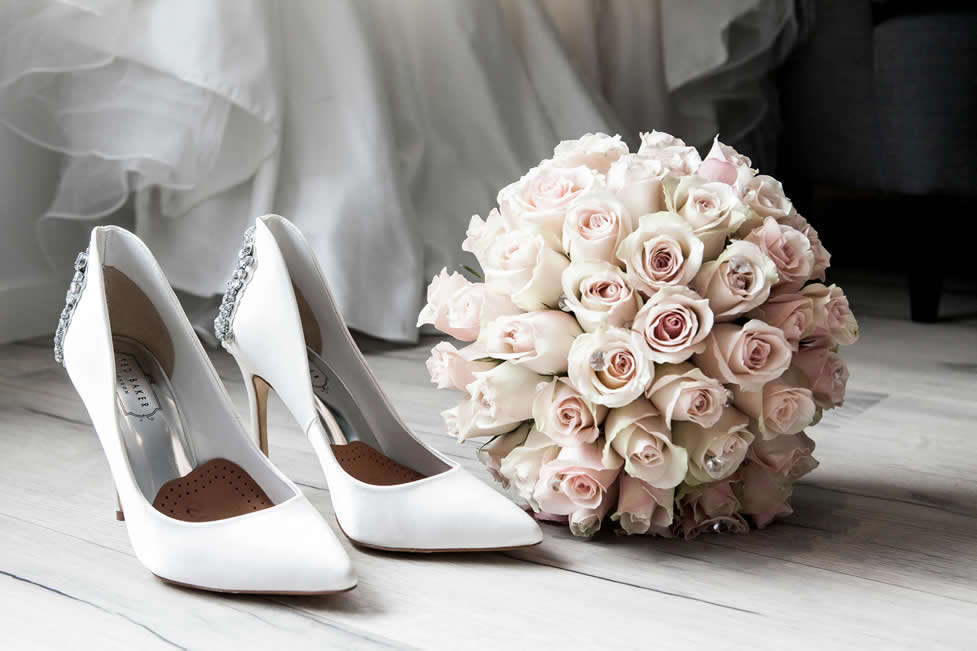
This is another opportunity to give flowers imbued with meaning. This topic required a bit more research in order to offer you a clear and thoughtful summary. While symbolic references can be found as early as the 15th century, particularly in Germany, it was mostly in 19th-century France that a structured list emerged, associating each wedding anniversary with a particular material—sometimes enriched with floral symbols. These lists began appearing in dictionaries and encyclopedias from that time onward.
However, the specifics vary significantly depending on country and tradition. In France, the most familiar version remains the one based on materials (wood, cotton, gold, etc.), although certain years are occasionally linked with flowers. In the United States, the classic list is also focused on materials. A flower is mentioned for the 4th anniversary, but without any specific species identified. Alongside these, a more symbolic—and sometimes commercial—floral version has developed independently, often promoted by florists. This list assigns a different flower to each wedding anniversary year.
A floral version also exists in France, even though it doesn’t exactly align with the traditional material-based anniversaries.
To guide you clearly, we will begin by highlighting the plants that appear in the traditional French material-based anniversary list—the one we feel most connected to—before presenting a more recent, commercially oriented list that offers one symbolic flower per wedding anniversary.
- 1 year – Cotton anniversary
The cotton flower embodies the softness of early days, the lightness of shared promises, and the purity of intentions. It also speaks of the ability to soften hardships through tenderness and care. Its immaculate whiteness evokes a sense of spiritual protection and inner freshness. It symbolizes luck, healing from past wounds, and the joyful simplicity of beginnings. - 8 years – Poppy anniversary
Radiant and delicate, the poppy expresses spontaneous passion, the fire of emotions, and the beauty of fleeting moments. It also evokes the need for rest after shared efforts—a welcome pause in the chaos of life. Carried by the wind, it symbolizes love's fragility and the care it requires. It is a flower of remembrance, vivid memory, and silent comfort. - 13 years – Lily of the valley anniversary
Lily of the valley, with its tiny white bells, is a messenger of renewal, quiet joy, and tender loyalty. It symbolizes the good fortune cultivated as a couple, and the purity of feelings preserved over time. Its delicate fragrance recalls the simple gestures that sustain love. A flower of humility, it also evokes gentle trust and sincere attachment. - 17 years – Rose anniversary
The rose, queen of flowers, captures the richness of love in all its nuances—passion, tenderness, admiration, friendship, even jealousy. It represents the evolution of romantic feeling, deepened and made more complex by time. Each color bears a message, each petal a promise. It celebrates the many emotions that the years have sealed into the relationship. - 46 years – Lavender anniversary
Fine and fragrant, lavender suggests a love that has found peace, depth, and stability. It evokes quiet fidelity, soothing care, and happy memories from a long journey shared together. Known for its calming properties, it also represents healing from old wounds. Its purple hue reflects a noble tenderness, almost meditative. - 55 years – Orchid anniversary
Rare and elegant, the orchid symbolizes a refined, profound love marked by a nearly sacred bond. A flower of quiet sensuality, it evokes inner beauty, cultivated patience, and emotional mastery. It honors the couple’s maturity, emotional depth, and ongoing capacity to bloom. To give an orchid is to acknowledge the union as a precious work of art. - 57 years – Azalea anniversary
With its generous and colorful blossoms, the azalea expresses shared joy, family harmony, and everyday tenderness. It symbolizes femininity, elegance, and the prosperity of a home built together. It also evokes a calm yet enduring passion, nurtured by respect and attentiveness. A warm flower, it speaks of lasting happiness. - 63 years – Lilac anniversary
With its fragrant clusters, lilac recalls the first stirrings of love, the freshness of early feelings, and the innocence of beginnings. It represents a love that remains youthful, enriched by deep memories. A spring flower, it suggests the continual renewal of the relationship. Its delicate scent invites tenderness, renewed closeness, and an awakening of the senses. - 66 years – Jasmine anniversary
Jasmine, a small white flower with intoxicating fragrance, conveys a sincere, faithful, and quiet love. It symbolizes purity of heart, the depth of bonds woven over time, and the simple tenderness of shared gestures. Its lingering scent recalls the quiet strength of deeply rooted love. A gentle and noble bloom, jasmine touches the soul with its luminous simplicity. - 84 years – Iris anniversary
The iris, stately and full of grace, is a symbol of wisdom, faith in the future, and inner peace. It embodies the nobility of a strong bond built on mutual admiration and deep understanding. Its natural radiance also reflects the pride of a long journey traveled together. The iris is a messenger of hope and heartfelt love that has endured across the decades.

 The lily of Mucha ring
The lily of Mucha ring
- 92 years – Lily anniversary
The lily, majestic and pure, represents sacred love, soul dignity, and inner light. It symbolizes a spiritual union imbued with respect, elevation, and transcendence. Its radiant whiteness evokes peace, ultimate tenderness, and the gentle strength of unwavering love. A solemn flower, it pays tribute to a lifetime of shared faithfulness.
Here is now a list of wedding anniversary flowers, mostly originating from the United States, which can serve as original and heartfelt gifts:
- 1st year – Carnation
The carnation, with its ruffled petals and subtle scent, evokes a love still new and delicately expressed. It symbolizes sincere feelings and the gentleness of emotional beginnings. This flower is also associated with luck and fidelity, offering a tender form of protection for the young couple. Its understated refinement is a reminder that deep bonds are woven through patience and affection. - 2nd year – Cosmos
Cosmos, with its airy and symmetrical flowers, reflects the gentle harmony and peaceful beauty of a balanced relationship. Its graceful blooming expresses the lightness of sincere emotions, supported by mutual trust. It also stands for quiet elegance and simple, steady happiness. A flower of romantic serenity, it speaks to a bond already well-rooted in shared understanding. - 3rd year – Sunflower
The sunflower, always turning toward the sun, embodies loyalty, shared joy, and a forward-looking spirit. It represents a radiant, enthusiastic, and steady love, nourished by mutual admiration. Its imposing form and bright heart also symbolize generosity and devotion in the relationship. A true solar flower, it invites the couple to continue walking forward together, with confidence and energy.
 Tranquility ring with hortensia flowers
Tranquility ring with hortensia flowers
- 4th Anniversary – Hydrangea
The hydrangea, with its generous, globe-shaped blooms, reflects the emotional richness accumulated over the seasons. It evokes gratitude for tender gestures, challenges overcome, and love shared. Its varied hues symbolize the complexity of human emotions—ranging from appreciation and modesty to profound depth. It embodies an abundance of affection, nurtured by sincerity and mutual respect. - 5th Anniversary – Daisy
The daisy, simple and radiant, evokes the freshness of beginnings and the sincerity of heartfelt impulses. Known for its association with love games and whispered promises, it embodies joyful fidelity and the authenticity of unadorned love. Its golden center encircles precious memories, like a crown of happy recollections. It reminds us that true love remains spontaneous, even after several years. - 6th Anniversary – Calla Lily
The calla lily, with its slender silhouette and understated elegance, symbolizes the discreet beauty of sincere and profound love. It represents a stable relationship, imbued with respect, admiration, and pure attachment. A flower of distinction, it reflects the quiet strength of a marital bond that matures gracefully. The calla lily also suggests the continuity of a noble, refined, and enduring sentiment. - 7th Anniversary – Freesia
The freesia, with its delicate fragrance and graceful curves, evokes pure and clear affection. It symbolizes unwavering loyalty and trust built on respect and attentive listening. This flower represents finesse, inner elegance, and subtle warmth. Its blooming signifies perseverance in gentleness and the constancy of true love, beyond doubts or storms. - 8th Anniversary – Lilac
The lilac, messenger of first emotions, recalls foundational tenderness and the magic of shared moments. It evokes gentle love, tinged with nostalgia and poetry, etched in the couple’s emotional memory. Its abundant blooming symbolizes fidelity to a still-living romantic ideal. As a flower of renewal, it breathes youthful energy into the heart of an already solid union. - 9th Anniversary – Poppy
The poppy, both fragile and flamboyant, embodies the ephemeral yet intense beauty of passionate love. It speaks of a bond that has withstood winds and silences, of peaceful closeness after turmoil. Its vivid color symbolizes the strength of emotions and the warmth of sincere commitment. It’s also a flower of remembrance, keeping alive the bright memories of the journey traveled. - 10th Anniversary – Daffodil
The daffodil, radiant herald of spring, symbolizes emotional renewal and mutual rediscovery after a decade of sharing. It expresses hope, rekindled enthusiasm, and light in everyday life. As a flower awakening the senses, it embodies the blossoming of matured tenderness and the promise of future projects. Its sunny hue evokes the warmth of the home built together. - 11th Anniversary – Tulip
The tulip, simple and graceful, symbolizes affirmed, stable, and clear love. It evokes a balanced relationship where each partner is recognized and appreciated for who they are. Its pure lines convey the authenticity of feelings, without embellishment or detour. It embodies the elegance of a lucid commitment, chosen daily with confidence and tenderness. - 12th Anniversary – Peony
The peony, sumptuous and fragrant, embodies the heart’s abundance, the sweetness of loving gestures, and shared sensuality. It symbolizes fully blossomed love, rich in experiences and complicity. Its generous blooming evokes the couple’s maturity and the fertility of the marital bond. It’s a flower of intense emotion, blending romanticism, deep joy, and faithful attachment. - 13th Anniversary – Chrysanthemum
The chrysanthemum, with its intricate floral structure, represents deep love woven through constancy and mutual recognition. It expresses loyalty, gratitude for the journey undertaken, and unalterable attachment. In some cultures, it also symbolizes longevity, inner peace, and lasting respect. It evokes emotional stability and the richness of enduring bonds. - 14th Anniversary – Orchid
The orchid, a rare and precious flower, symbolizes the elegance of refined, secret, and profound love. It reflects a unique bond shaped by patience, attentive listening, and delicacy. Its subtle beauty conveys the silent harmony of a couple united in mutual respect. It also signifies mastered sensuality and a serene, spiritually elevated love. - 15th Anniversary – Rose
The rose, in its diverse forms and colors, expresses all facets of love: ardent passion, affectionate tenderness, faithful friendship, or deep respect. It embodies universal, accomplished, and embraced love, nurtured by thoughtful gestures and sincere emotions. Each petal tells a story; each thorn recalls the trials overcome together. As the flower of lovers, it reigns supreme in anniversary celebrations. - 20th Anniversary – Aster
The aster, star-shaped, represents constancy, fidelity, and clarity of feelings over time. It evokes discreet yet profound affection, capable of illuminating daily life with its soothing presence. This flower symbolizes mutual trust, stability, and emotional maturity. Its late blooming illustrates the enduring beauty of love that doesn’t fade. - 25th Anniversary – Iris
The iris, a celestial messenger in mythology, embodies the elevation of feelings, the nobility of the marital bond, and the wisdom of matured hearts. It symbolizes the balance between passion, reason, and renewed admiration. Its graceful form and vibrant color recall the poetic strength of love that still shines. For the silver anniversary, the iris pays tribute to the enduring beauty of the union. - 30 years – Lily
The lily, majestic and pure, evokes the grandeur of a serene, clear, and faithful love. It embodies the clarity of intentions, the honesty of feelings, and the nobility of kept commitments. A spiritual flower, it also suggests inner peace and the harmony of a home built together.
Its radiant whiteness celebrates the beauty of a bond rooted in the purity of the heart. - 40 years – Gladiolus
The gladiolus, proud and upright, represents strength of character, courage, and perseverance in long-term love. It embodies mutual admiration born from shared trials and years of complicity. A warrior flower, it symbolizes a relationship victorious over time. It reflects a union built on effort, loyalty, and the pride of a journey taken together. - 50 years – Violet
The violet, discreet and fragrant, symbolizes quiet tenderness and unwavering fidelity. It evokes deep affection, rooted in humility, modest gestures, and everyday kindness. It is a flower of memory, silent respect, and gentle but steadfast love. It celebrates the delicacy of a bond that has gracefully endured through the decades.
Other commemorations and associated flowers
Beyond the flowers traditionally linked to months or wedding anniversaries, others are associated with specific events, a few of which are mentioned here. Due to their symbolism and cultural significance, their meaning may vary from one country to another.
Wedding flowers
In addition to wedding anniversaries, certain flowers are traditionally used on the very day of the ceremony. Whether part of the bridal bouquet, boutonnieres, table arrangements, or a floral arch, these blooms take on a special meaning depending on their color and symbolism. Keeping a trace of them in the form of a piece of jewelry, a dried flower, or an engraved stone can be a way to prolong the magic of the moment.
- Peony – Highly prized in weddings for its lush and romantic form, it symbolizes marital bliss, prosperity, tenderness, and lasting harmony.
- Hydrangea – Often used in floral arrangements, it evokes gratitude, sincerity, and emotional fulfillment in the relationship.
- Orange blossom – Associated since antiquity with purity, virginity, and fertility. It was traditionally worn in bridal wreaths, especially in the 19th century.
- Rose – A universal symbol of love. The white rose suggests purity and fidelity, the pink rose tenderness and delicacy, and the red rose deep passion.
- White lily – Linked to nobility, innocence, and spiritual union. It is often chosen for religious ceremonies.
- Baby’s breath (Gypsophila) – Light and airy, it often complements bouquets and symbolizes purity of heart and eternal love.
- Lavender – Beyond its soothing fragrance, it speaks of devotion, serenity, and a peaceful love.
- Daisy – Associated with simplicity, sincerity, and loyalty. It adds a cheerful, rustic touch to outdoor weddings.
- Sunflower – Sometimes chosen for summer weddings, it represents admiration, loyalty, and joyful growth
. - White camellia – A symbol of perfection, quiet admiration, and longevity in love.
Birth and christening flowers
Beyond the birth flowers traditionally linked to each month, some varieties are customarily offered to celebrate the arrival of a child or to accompany a christening. Whether in bouquets for the new mother, floral arrangements for a reception, or symbolic blooms tucked into a keepsake, these flowers embody the gentleness of beginnings, innocence, and the promise of a bright future.
- White lily – With its radiant whiteness, it symbolizes purity, innocence, divine blessing, and the welcoming of a new soul.
- Daisy – With its simple and cheerful shape, it evokes tenderness, sincerity, the freshness of childhood, and unconditional love.
- Pink rose – It embodies sweetness, maternal affection, the tenderness of first moments, and the delicate bond uniting the child with their family.
- White or pastel freesia – Often chosen for its graceful appearance and subtle fragrance, it symbolizes purity of heart, trust, and protection.
- White camellia – Associated with perfection and benevolence, it conveys a quiet, profound love for the child being welcomed.
- Baby’s breath (Gypsophila) – As a light cloud in bouquets, it represents purity, childlike innocence, and the promise of a peaceful future.
- Cornflower – With its soft color and peaceful symbolism, it can be linked to childhood, candor, and wonder.
- Daisy (Bellis perennis) – The rustic cousin of the larger daisy, it may symbolize humility, pure joy, lightness, and the tenderness of early years.
Valentine’s Day and love flowers

Of course, it’s impossible to talk about symbolic flowers without mentioning Valentine’s Day, one of the most iconic moments to give a bouquet and express one’s feelings. These flowers speak of love, passion, desire, and tenderness. Given alone or accompanied by a piece of jewelry that reflects the motif, they become a memento of a precious moment and a shared emotion.
- Red Rose: Classic and timeless, it embodies passionate love, ardent romance, and deep desire.
- Red Tulip: A symbol of sincere, faithful, and lasting love, often chosen for its elegant simplicity.
- Orchid: Evocative of sensuality, it represents rare beauty, refined charm, and delicate love.
- Red Camellia: In the language of flowers, it expresses deep admiration and devoted love.
- Red Anemone: It evokes loving anticipation, passion sometimes tinged with worry, and the strength of emotions.
- Red Geranium: In certain traditions, it is associated with ardent love and emotional loyalty.
- Red or Pink Lily: The lily can also evoke noble, pure, and even sacred love, depending on the chosen shade.
- Cherry Blossom: In Asian cultures, it represents fleeting beauty, fragile yet radiant love.
- Violet: Subtle yet full of meaning, it symbolizes sincere attachment, modest love, and faithful devotion.
 Misao ring with cherry blossom
Misao ring with cherry blossom
Flowers associated with death, mourning, and funerary commemorations
Although this type of commemoration related to death is less festive, it marks a significant moment and a memory we carry with us. Having or wearing a symbol can also be important for navigating these difficult stages. These flowers are often chosen for funeral arrangements, wreaths, or compositions placed on graves during All Saints' Day or other personal or collective tributes.
- Lily: Associated with purity and regained innocence, it also evokes peace for the soul of the deceased. Widely used in Christian ceremonies.
- Chrysanthemum: Very common in Europe, especially in France, to honor the dead. It symbolizes mourning, lasting memory, and eternity.
- White Carnation: Represents loyalty, deep respect, and discreet love for the departed.
- White Rose: Embodies purity of heart, reverence, and eternal love.
- Red Rose: Expresses deep and lasting attachment, often related to an unchanging love beyond death.
- Calla (Arum): Its pure and noble shape is often associated with dignity, the immortality of the soul, and spiritual transformation.
- Iris: A symbol of hope and passage to another world, it also carries inner peace and guidance.
- Hydrangea: This flower evokes gratitude towards the deceased and collective remembrance. It underscores the shared attachment to the departed.
- Gladiolus: Tall and majestic, it embodies moral strength, respect, and sincerity of feeling.
- Violet: Delicate and subtle, it expresses modesty, reverence, and the silent sadness of loss.
- Anemone: A sensitive and fragile flower, it symbolizes the fleeting nature of life and the pain of mourning.
- Lotus Flower: In Buddhist and Hindu traditions, it represents inner peace, spiritual rebirth, and the elevation of the soul.
- Baby’s Breath (Gypsophila): With its small white flowers, it conveys the delicacy of memories, simplicity, and purity of intention.
- Laurel: Used in ancient times to crown heroes, it symbolizes eternity, honor, and imperishable memory.
- Crocus: A transitional flower, associated with the return of spring, it evokes renewal and passage, particularly in symbolic rites of the afterlife.
Other occasions to commemorate with flowers
Beyond well-known holidays and major floral traditions, certain occasions also deserve to be marked with flowers. Offering a flower—or wearing one as part of a piece of jewelry—is a universal gesture of emotion, gratitude, remembrance, or celebration. These customs often vary depending on the country or culture. Here are a few meaningful examples:
- Remembrance Day (Armistice, November 11):
- Red Poppy: In Commonwealth countries, it honors soldiers who died in combat, evoking the blood spilled on the battlefield.
- Bleuet de France (French Cornflower): A symbol of remembrance and solidarity with war veterans, worn in France during official commemorations.
- Red Poppy: In Commonwealth countries, it honors soldiers who died in combat, evoking the blood spilled on the battlefield.
-
Mother’s Day:
- Pink Carnation: Traditionally associated with maternal love, tenderness, and gratitude.
- Peony: A symbol of sincere family love, prosperity, and shared happiness.
- Lavender: Evokes gentleness, calm, and the soothing bond between mother and child.
- White Lily (in Japan): Used to celebrate the purity and elegance of motherhood.
- Grandmother’s Day:
- Violet: A symbol of modesty, quiet affection, and respectful tenderness.
- Hyacinth: Expresses joy in life and genuine fondness.
- Lily of the Valley: Sometimes given to represent luck and renewed happiness.
- Violet: A symbol of modesty, quiet affection, and respectful tenderness.
- Graduation and Achievement:
- Sunflower: The quintessential solar flower, representing success, optimism, and inner strength.
- Gladiolus: Embodies victory, strength of character, and perseverance through academic or life challenges.
- Laurel: In Greco-Roman tradition, a symbol of triumph and intellectual excellence (the origin of the term "baccalaureate").
- Sunflower: The quintessential solar flower, representing success, optimism, and inner strength.
- Chinese New Year:
- Plum Blossom: A symbol of renewal, courage, and rebirth through adversity.
- Narcissus: Seen as a sign of good fortune and prosperity for the coming year.
- Hanami in Japan:
- Cherry Blossom (Sakura): A fleeting celebration of life’s beauty, symbolizing purity, fragility, and springtime renewal.
- Cherry Blossom (Sakura): A fleeting celebration of life’s beauty, symbolizing purity, fragility, and springtime renewal.
- Día de los Muertos (Mexico):
- Marigold (Tagetes or Cempasúchil): A symbolic guide for the souls of the departed, it adorns altars and graves during this joyful and colorful celebration of the dead.
- Saint John’s Day (Southern Europe, Pagan and Christian Traditions):
- Fern or St. John’s Wort: Believed to bring good luck and ward off evil spirits.
- Crowns of Wildflowers: Worn or woven to celebrate the light of the summer solstice.
